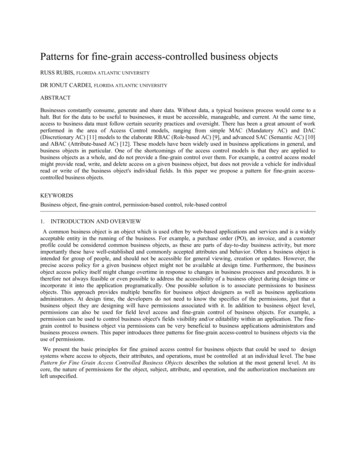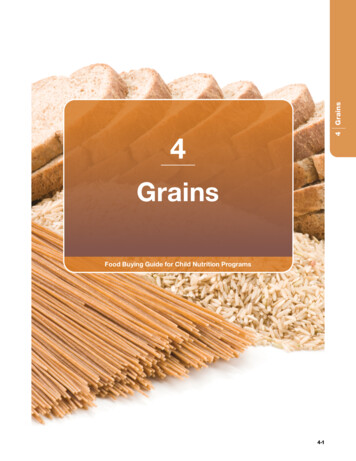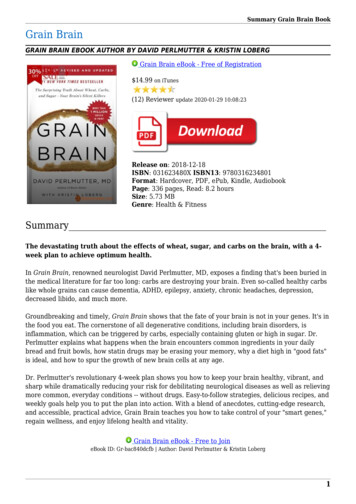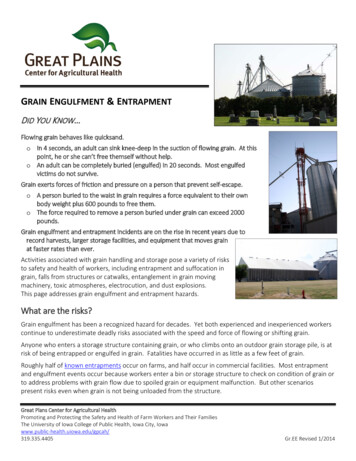
Transcription
Patterns for fine-grain access-controlled business objectsRUSS RUBIS, FLORIDA ATLANTIC UNIVERSITYDR IONUT CARDEI, FLORIDA ATLANTIC UNIVERSITYABSTRACTBusinesses constantly consume, generate and share data. Without data, a typical business process would come to ahalt. But for the data to be useful to businesses, it must be accessible, manageable, and current. At the same time,access to business data must follow certain security practices and oversight. There has been a great amount of workperformed in the area of Access Control models, ranging from simple MAC (Mandatory AC) and DAC(Discretionary AC) [11] models to the elaborate RBAC (Role-based AC) [9], and advanced SAC (Semantic AC) [10]and ABAC (Attribute-based AC) [12]. These models have been widely used in business applications in general, andbusiness objects in particular. One of the shortcomings of the access control models is that they are applied tobusiness objects as a whole, and do not provide a fine-grain control over them. For example, a control access modelmight provide read, write, and delete access on a given business object, but does not provide a vehicle for individualread or write of the business object's individual fields. In this paper we propose a pattern for fine-grain accesscontrolled business objects.KEYWORDSBusiness object, fine-grain control, permission-based control, role-based control1.INTRODUCTION AND OVERVIEWA common business object is an object which is used often by web-based applications and services and is a widelyacceptable entity in the running of the business. For example, a purchase order (PO), an invoice, and a customerprofile could be considered common business objects, as these are parts of day-to-day business activity, but moreimportantly these have well-established and commonly accepted attributes and behavior. Often a business object isintended for group of people, and should not be accessible for general viewing, creation or updates. However, theprecise access policy for a given business object might not be available at design time. Furthermore, the businessobject access policy itself might change overtime in response to changes in business processes and procedures. It istherefore not always feasible or even possible to address the accessibility of a business object during design time orincorporate it into the application programatically. One possible solution is to associate permissions to businessobjects. This approach provides multiple benefits for business object designers as well as business applicationsadministrators. At design time, the developers do not need to know the specifics of the permissions, just that abusiness object they are designing will have permissions associated with it. In addition to business object level,permissions can also be used for field level access and fine-grain control of business objects. For example, apermission can be used to control business object's fields visibility and/or editability within an application. The finegrain control to business object via permissions can be very beneficial to business applications administrators andbusiness process owners. This paper introduces three patterns for fine-grain access-control to business objects via theuse of permissions.We present the basic principles for fine grained access control for business objects that could be used to designsystems where access to objects, their attributes, and operations, must be controlled at an individual level. The basePattern for Fine Grain Access Controlled Business Objects describes the solution at the most general level. At itscore, the nature of permissions for the object, subject, attribute, and operation, and the authorization mechanism areleft unspecified.
The pattern system from Figure 1includes four patterns and can be expended to cover more cases with access controlsystems that are more sophisticated. The pattern system includes the specialized Rights Based Pattern relies on asimple CRUDC access rights, the Role Based Fine Grain Access Control pattern, and the Access Control List (ACL)Fine Grain Access Control pattern, that implement various permission mechanisms abstracted in the top-levelPattern for Fine Grain Access Controlled Business Objects.2.2.1FINE-GRAIN ACCESS CONTROL PATTERNIntentA holistic access control to business objects is not sufficient as business objects are often comprised of multiple parts(fields) and may contain references to other business objects. Objects need to be designed with built-in support forfine-grained access control to their elements. Consequently, we need a model which provides a fine-grain accesscontrolled business objects. In this pattern we present an approach for access control to an object and to its individualattributes and operations.2.2ExampleConsider a simple customer business object, which consists of customer name, address, telephone, email, credit cardinfo, and ordering history.The customer data should only be available to individuals who need it and have the right (permission) to access it.Most of the time, only parts of the customer's data is needed by those who access it. For example, a marketingdepartment might need to see the customer's order history and contact info, but they should not be able to see thecustomer's credit card info. On the other hand, the ordering department should have access to the customer's creditcard info in order to be able to validate it, but might not have a valid business reason to see the order history.Access to the customer object and its fields could be programmed into the object itself. This approach however is notdesirable as it does not take into account constantly changing business conditions and processes. Any changes to theway customer object is accessed and controlled would require additional programming, which is often expensive andtime consuming.An alternative is to associate permissions with the customer object. Thus, for example, a Marketing Departmentpermission can be associated with the customer business object, and its contact info and ordering history details. Atthe same time, an Ordering Department permission can be associated with the customer business object's credit carddetails. Both permissions are associated with the customer object, but each propagates to a different set of its fields,thus each permission provides a fine-grain access control over the customer object.
2.3ContextYou are designing a new business object and need a way to provide fine-grain access control to the object and itsfields when your business object is deployed in your business application. The fine-grain access control should beconfigurable and verifiable. Finally, the fine-grain access to the business object should also provide control over thebusiness object's fields visibility and editability.2.4ProblemDetermining business object's access control and fine-grain accessibility of its fields at design time orprogrammatically is not always feasible or possible. How can I design a business object's fine-grained access controlwhich can be parameterized, and thus configurable at run time or at the time of deployment?2.5SolutionThe UML class diagram for the pattern's design is shown in Figure 2. The business object metamodel is suitable fordifferent runtime environments (such as web client, web backend, web services, Java virtual machine). It include thefollowing concepts: BusinessDataObject class: for business objects. Such an object is uniquely identified and all objects from thesame class have similar states and behavior, as per the object-oriented paradigm. A class state is defined byits attributes (i.e. properties) and an object is capable to execute a set of operations. Attribute class: an object of this class describes the name and type of a business object's attribute. Theruntime value of an attribute is not addressed in this pattern. A BO may have zero or more Attribute objects,one for each of its attribute. Operation class: each operation supported by a BO is described by an Operation object. Its attributes mayinclude name, return value, parameter list.Access rights and permissions are represented in this design by corresponding classes for BOs, their attributes, andoperations. A BO instance has an optional DataAccessRightsDescriptor object that represents the rights assigned tothe BO in an abstract and opaque way. An Attribute object is also associated with an optionalDataAccessRightsDescriptor instance, describing the access rights endowed to this particular attribute. TheOperationRightsDescriptor class describes the rights assigned for a particular operation for a BO, again in an abstractway.The Subject class represents the entity that access a BO's attributes and executes its operations. A Subject's accesspermissions are described by a PermissionsDescriptor object.The Runtime class abstracts the runtime system (e.g. web application server, JVM, browser Javascript engine) andaggregates subjects and BO instances.The PermissionAuthority object is responsible for authorizing access by Subjects to BOs, attributes, and operationsdepending on the access rights descriptors associated for a particular access attempt by a Subject. ThePermissionAuthority checkDataAccess() and checkOperationAccess() methods implement the validation for access toa BO's attribute and operation, respectively, and encapsulate policies for dealing with defaults and conflicts.
Figure 2: The design of the Fine Grain Access Control for Business Objects pattern.2.6Known usesMost, if not all major Commercial Off The Shelf (COTS) Enterprise Resource Planning (ERP) developers such asOracle and SAP to name the two biggest, employ some sort of permission-based access to their data forms and dataobjects. They too apply permission-based access at both the full object level, as well individual object fields. Aribafor example uses permission objects which can be assigned to role objects, which in turn are then assigned to userobjects. Developers can then assigned permissions to actions such as editibility and visibility of the fields within agiven object. This allows Ariba business objects to be accessed via permissions, without the need for further coding.3.3.1ROLE BASED FINE GRAIN ACCESS CONTROL PATTERNIntentPresents an approach for access control to a business data object and its individual attributes and operations, thatdepends on subject's roles and the access rights assigned for specific roles to the object, attributes, and operations.3.2ContextAny environment where subjects (users, clients) are assigned to roles and access to protected business objects, theirattributes, and operations must be authorized differently based on the subject's roles.3.3ProblemSubjects must access protected objects, their attributes, and execute their operations with discrete level of accesscontrol and in a way that is scalable and convenient with a large number of objects and subjects. Access permission isgranted by a central authority.
3.4SolutionThis pattern, shown in Figure 3, is derived from the more abstract pattern for Fine Grain Access Controlled BusinessObjects, described above. The access right information for business objects (DataAccessRight class) and attributes(OperationExecuteRight class) are associated with roles identified by Role objects. The accessType attribute indicatesthe rights type (e.g. read, update) that are possible for subjects with a particular role. Similarly, theOperationExecuteRight object specifies that subjects with the associated Role has the right to execute thecorresponding operation.Roles form a hierarchy defined by the subRoleOf association: a subject member of a subrole A is considered to be amember of role B if there exists an association A subRoleOf B between objects A and B.
}return FALSE}A similar algorithm validates subject access to operation execution.3.5ConsequencesUsing roles allows the application developers and administrators to reduce the effort for specifying accesspermissions as large groups of subjects (e.g. users, web clients) can be assigned to a relatively small number of roles.In addition, access rights for large sets of objects (and their fields) can be handled efficiently through automation anddefault policies. A per-field rights mechanism provides a much finer level of access control that is suitable for currentlarge web-based systems.3.6Known UsesUnix file access rights is based on a combination of groups, users, owners, and permissions. Users are organized intogroups, and each group is assigned read, write and execute permissions.4.4.1RIGHTS BASED FINE GRAIN ACCESS CONTROL PATTERNIntentA basic approach for access control that requires granular permissions to objects, attributes, and operations inenvironments with a manageable number of subjects.4.2ContextBusiness objects and their attributes require rights for specific types of access, such as create/read/update/delete andcopy. The access right for an operation is to execute it. The environment makes it feasible to assign access rights tosubjects for specific objects, attributes, and their operations. This could be an execution runtime (OS), a virtualmachine, or a distributed (web) system not open to external clients, for instance.4.3ProblemAccess to Business Objects, their attributes, and operations must be given individually to subjects in a granular way.A subject may be given access to an object, but not to all its attributes or operations. Also, permissions to read,update, copy, create, and delete must be differentiated – per attribute. The system must apply policies to deal withsituations where a subject's rights for an object conflicts with the specific access rights of that subject for the requiredattribute/operation. For instance, a subject that has the Read access right for an object may lack the Read right for anattribute it needs to read. One incarnation of this pattern may apply the principle of least privilege and deny access.4.4SolutionThe design in Figure 4 assigns RightsDescriptor objects to a subject that describe specific access type allowed forthe subject to individual objects, their attributes, and operations. An optional RightsDescriptor object is assigned toeach BO, attribute, and operation to describe access rights that apply for all subjects that request access. ThePermissionAuthority object validates access by matching the rights a subject has for a specific object, attribute, oroperation with the (optional) rights descriptor owned by corresponding object, attribute, or operation. Validation mustconsider cases when a subject does not have access rights objects for the requested access and when the object (orattribute/operation) has no rights descriptor. Best practices (assigning least privileges) can be applied.
Update Permission. Updating business object is a daily occurrence within any organization. For example, anemployee's marital status changes and needs to be reflected in the employee object, or a customer address changed,and needs to be updated in the customer object. However, the ability to update business objects should not be grantedto everyone. A clerk in the warehouse should be able to view customer address for shipping purposes, but should notbe able to update it. The update access control can be solved via permissions. By mapping business object's UpdatePermission attribute to a permission (or a set of permissions), we can control who can update the given businessobject. We can also apply are more fine-grain control to business fields by applying a different permission (or a set ofpermissions) to those fields which should only be accessible for update to a narrower audience (see example in Table1).Delete Permission. Deleting a business object is not the same operation as deleting the object in a programminglanguage. Deleting a business object may require deleting some language objects, deleting some database entries, etc.Deleting a business object should be the least used action, and least accessible action, but it is an extremely sensitiveone. Deleting business objects is highly discouraged and should only take place in rare circumstances. Some businessapplications, such as Ariba, do not allow any deletion of business objects. Instead they “deactivate” unwantedbusiness objects within the application, thereby rendering them unavailable to the end users and processes. Even inthe case of deactivation (logical delete), only a very narrow set of audience should have ability to delete businessobjects. Mapping a permission to Delete Permission attributes will accomplish that limited access. Delete operationcan also be applied at business object field level. Note: in this pattern delete of field data is different from updating offield data. Updating field involves changing field value from one value to another (i.e. changing employee maritalstatus from Single to Married). Deleting field value is removing any value within that field and leaving it blank (ornill or null).Copy Permission. Copy is probably the least utilized action in most business applications, yet could greatly increaseuser productivity and decrease data errors. For example, when reordering office supplies, it would be much quicker tocopy an existing order and just modify item quantities as opposed to creating a new order from scratch, especially ifthe order has a large number of items. Not only does copy offer much faster way to order the needed supplies (userproductivity), it also eliminates errors which could have been introduced has the order been created from scratch. Atthe filed level copy is most often utilized when a business object contains data of Master/Detail type. Copy can beused to copy a detail field (which often contains numerous fields).All object level permissions are propagated by to the attributes and operations of the object. At the attribute andoperation level, these permissions can be overridden by explicitly assigning another permission to an attribute oroperation.At design time we do not need to assign any value to each of the above attributes. Rather, each attribute will bemapped to a permission via parameter.The same set of attributes is also added to individual fields within the business object at design time. The attributes atthe object level and at the object field level allow for a fine-grain control over the business object and its fields at runtime, without the need to know the actual permissions at design time.The following table provides an example of how permissions can be mapped to a business object and its fields. Weuse “/” to denote object/field relationship. For example, a customer object and customer credit card would be denotedas Customer/CreditCard.
Customer ObjectCustomer/CreditCardFieldCreate PermissionCustomerServiceRead PermissionCustomerServiceFinanceor FinanceUpdate PermissionCustomerServiceFinanceor FinanceDelete PermissionFinanceCopy ble 1: Permission-based field accessAbove table shows permission mappings for Customer object and its fields. Users with CustomerService permissionare allowed to create, read, update, and copy a customer object, however only users with Finance permission candelete a customer object. Because Customer.Telephone field does not have any permissions assigned explicitly, itinherits the access permissions of the object itself. The field Customer/CreaditCard on the other hand can only beupdated or viewed by users with Finance permission. Consequently, users with CustomerService permission mayenter customer credit card info at the time of customer business object creation, but do not have access to updated orview customer credit card info subsequently.Thus via permissions we can provide a fine-grain access control to a business object as a whole, and to its individualfields.The permissions associated with the given business object access do not have to be determined at design-time.Rather, the mapping of permissions to objects should be parameterized, thereby enabling the creation of theassociations at run-time. Assigning permissions at run-time also enables us to group the business objects based on thepermission(s) to which they are mapped.As our intention is to provide fine-grain access control to business objects, we need to define additional permissionsfor the object attributes and the object operations. These are different from the object permissions, but must be relatedto them at least by a default propagation scheme. Object attributes will have these permission attributes: CreatePermission. A permission value mapped to this attribute indicates that users with this permission are allowed to createthe given business object attributes. This is only possible for those attributes that allow this by their structure.Read Permission. Another word for reading an object attribute is viewing it. A permission to read an operationallows access to the history of operation calls. This is a common and useful action in business objects. For instance,consider an account object. It is frequent that there is a need to consult the account transactions.Update Permission. Updating business object attribute is a daily occurrence within any organization. For example,using the the example above, an employee's marital status changes and needs to be reflected in the employee object,this action needs permission to update the object, as well as permission to update the “MaritalStatus” attribute.Delete Permission. Deleting a business object attribute is only possible for those attributes that allow this by theirstructure.As for operations, we also need specific permissions that are different from the object permissions, but must berelated to them at least by a default propagation scheme. Object operations will have these permission attributes:Call Permission. This is a permission that allows invoking the given operation on the given object instance. Callingan operation requires a permission for updating the object instance, plus a permission to call the operation.Finally, we should define default propagation rules for permissions so that when an object is assigned permissionsthe attributes and operations are consistently assigned their corresponding permissions.Because we can group permissions into roles, we can easily incorporate our configuration into an existing RoleBased Access Control (RBAC) type architectures.
4.5ConsequencesThis pattern is suitable for systems where it is feasible to assign all subjects rights descriptors for objects they wouldaccess, including for their attributes, operations. For each object (and each of its fields) it only requires optionalspecification for just one rights descriptor that applies to all subjects. This mechanism is simpler, but gives lesscontrol compared to the role-based alternative, and alsoe does not scale with a large number of subjects.5.5.1RELATED PATTERNS AND FRAMEWORKSDiscretionary Access Control (DAC)The DAC pattern enforces access control based on user identities and the ownership of objects. The owner of anobject may grant permission to another user to access the object, and the granted user may further delegate the permission to a third person. [11]5.2Mandatory Access Control (MAC)The MAC pattern governs access based on the security level of subjects (e.g., users) and objects (e.g., data). Ac-cessto an object is granted only if the security levels of the subject and the object satisfy certain constraints. The MACpattern is also known as multilevel security model and lattice-based access control. [11]5.3RoleBased Access Control (RBAC)The RBAC pattern enforces access control based on roles. A role is given a set of permissions, and the usersassigned to the role acquires the permissions given to the role. Since the RBAC pattern is based on roles which are ingeneral fewer than the number of users, it is useful for managing a large number of users. [9]5.4Attrubite-based Access Control (ABAC)Attribute-based access control defines an access control architecture whereby access rights are granted to usersthrough the use of policies which combine attributes together. The policies can then use any type of attributes (userattributes, resource attribute, etc.). Attributes can be compared to static values or to one another thus enablingrelation-based access control. [12]5.5Semantic Access Control (SAC)The Semantic Access control model was created in 2002. The fundamentals of this semantics-based access controlmodel are the definition of several metadata models at different layers of the Semantic Web. Each component of SACrepresents the semantic model of a component of the access control system. The semantic properties contained in thedifferent metadata models are used for the specification of access control criteria, dynamic policy allocation,parameter instantiation and policy validation processes. [13]6.CONCLUSIONS AND FUTURE WORKThe permission-based access control to common business objects and their entities provides a clear, generic andextendible design-time approach to securing access to business data. It allows for use of as many or as fine-grainedpermissions to control access to various parts of business data in a declarative way.It is important to note that the permissions are independent of the access control model used. The content of thepermission-specific attributes can be adapted to each access control model. For instance, in a Mandatory AC modelthe content of a permission attribute would be the security level, in the Discretionary AC model it would point tospecific users, in RBAC it would contain roles, and finally in the Semantic AC model, it would point to AC policies.7.ACKNOWLEDGMENTSWe would like to thank Antonio Maña for his invaluable feedback and support during the shepherding of this paper.8.REFERENCES[1] A Guide To The Sarbanes-Oxley Act, The Sarbanes-Oxley Act of 2002, DOI http://www.soxlaw.com/[2] Fowler M., 1997. Analysis Patterns: Reusable Object Models, Addison-Wesley Longman.
[3] Daum B., 2003. Modeling Business Objecs with XML Schema, Morgan Kaufmann Publishers.[4] Eriksson H.-E., Penker M., 2000, Business Modeling with UML: Business Patterns at Work, OMGPress / Wiley Computer Publishing[5] Adams J., Koushik S., Vasudeva G., Calambos G., 2002, Patterns for e-business: A Strategy for Reuse,IBM Press[6] Buckl S., Matthes F., Monahov I., Roth S., Schulz C., Schweda C.M., 2012. Enterprise ArchitectureManagement Patterns for Company-wide Access Views on Business Objects, ACM Transactions on AppliedPerception, Vol. 2, No. 3, Article 1, Publication date: May 2012.[7] Chang K.Y., Chen L.S., Lai C.K., 1999. Document-View-Presentation Pattern, Department of ElectricalEngineering, National Cheng-Kung University, Taiwan.[8] E. B. Fernandez and Pan R. A Pattern Language for Security Models. In Proceedings of the 8thConference on Pattern Language of Programs (PloP), Monticello, IL, 2001.[9] D. Ferraiolo, D. R. Kuhn, and R. Chandramouli. Role-Based Access Control. Artech House, 2003.[10] Yagüe, M. I., & Maña, A. (2005). Semantic access control model: A formal specification. In ComputerSecurity–ESORICS 2005 (pp. 24-43). Springer Berlin Heidelberg.[11] Kim, D. K., Mehta, P., & Gokhale, P. (2006, October). Describing access control models as designpatterns using roles. In Proceedings of the 2006 conference on Pattern languages of programs (p. 11). ACM.[12] Yuan, E., & Tong, J. (2005, July). Attributed based access control (ABAC) for web services. In WebServices, 2005. ICWS 2005. Proceedings. 2005 IEEE International Conference on. IEEE.[13] Semantic Access Control, A Semantics-based Access Control Model for Open and DistributedEnvironments, http://www.lcc.uma.es/ yague/Semantics-basedAccessControl.html
We present the basic principles for fine grained access control for business objects that could be used to design systems where access to objects, their attributes, and operations, must be controlled at an individual level. The base Pattern for Fine Grain Access Controlled Business Objects describes the solution at the most general level. At its










